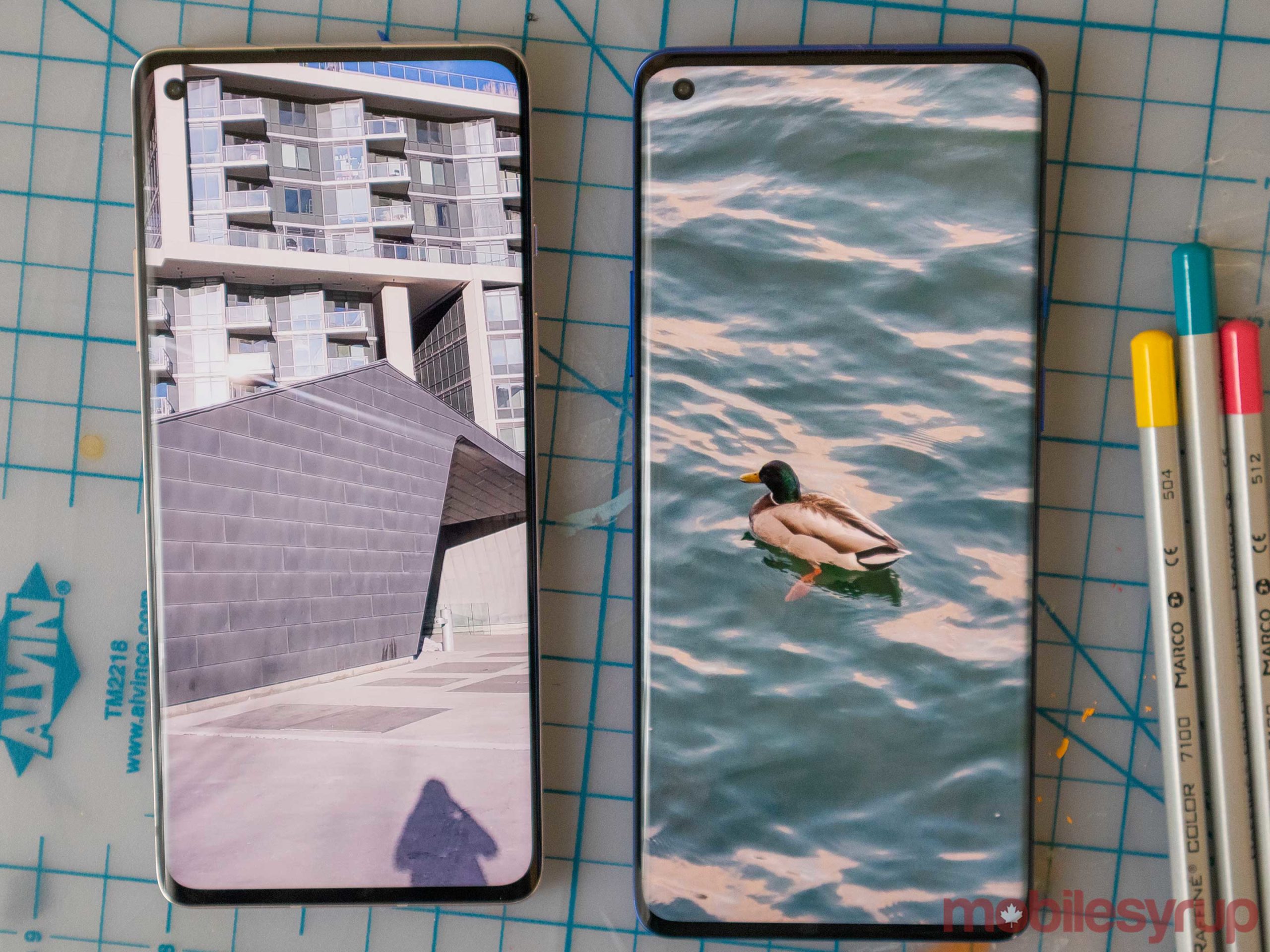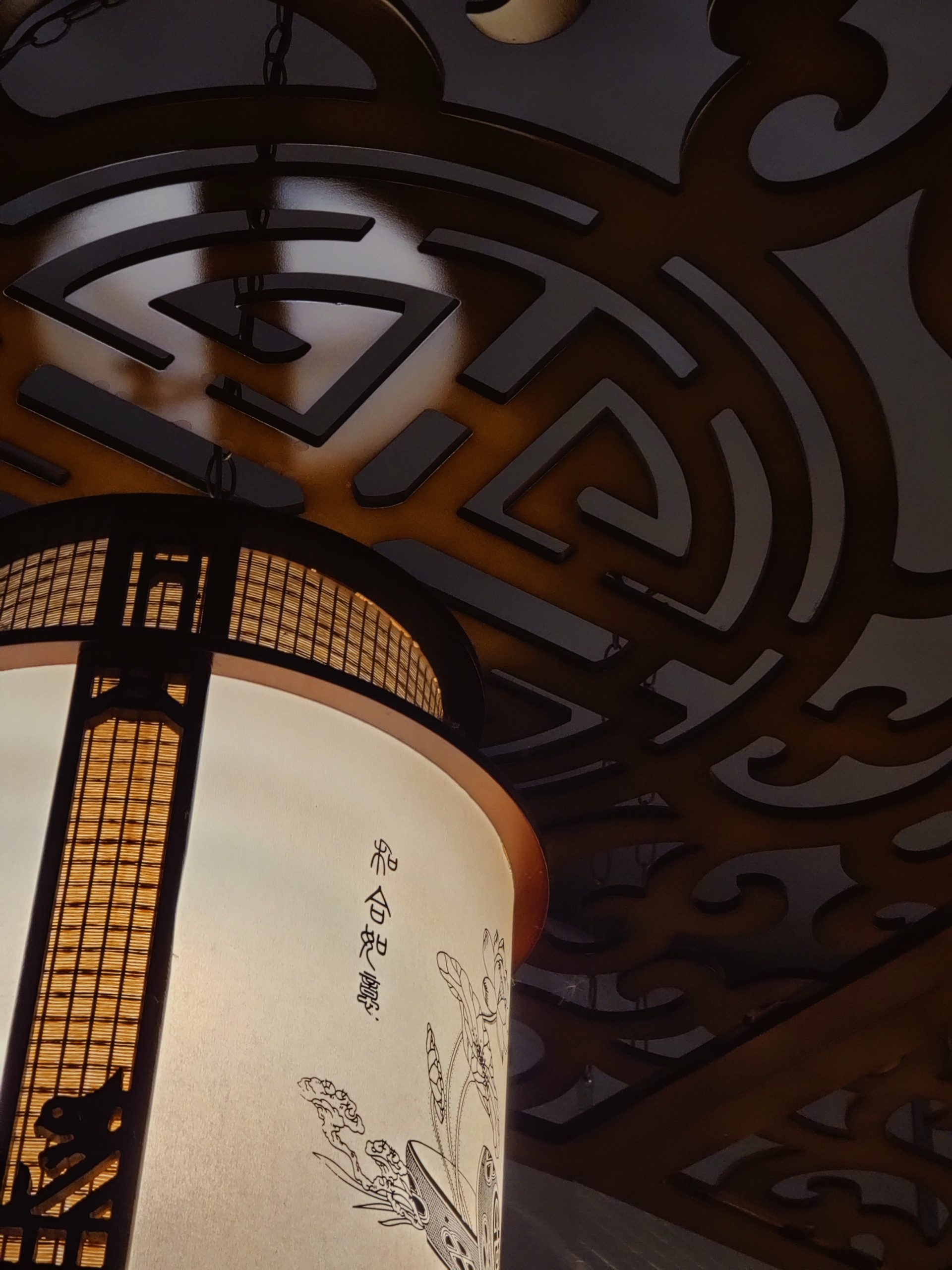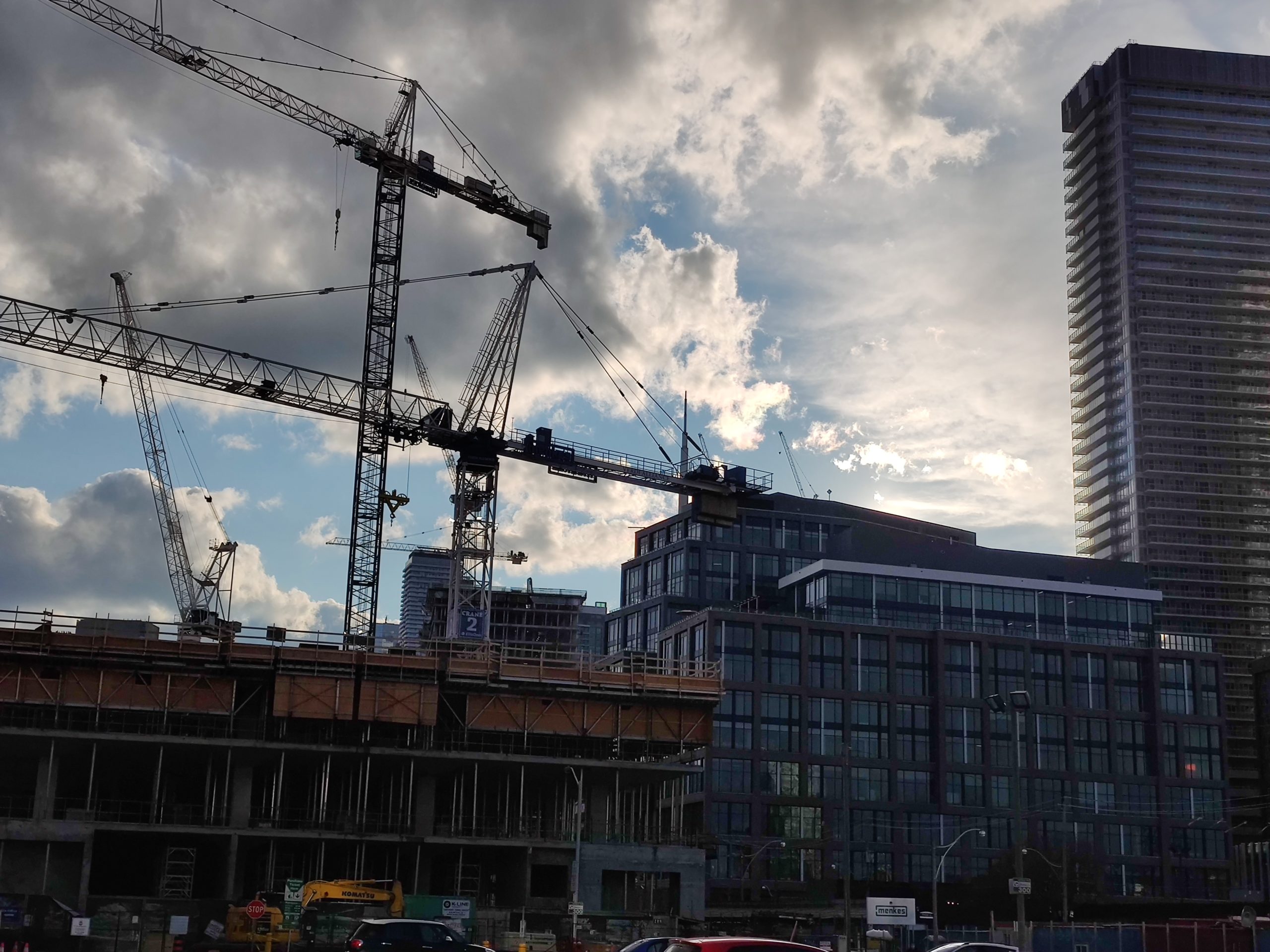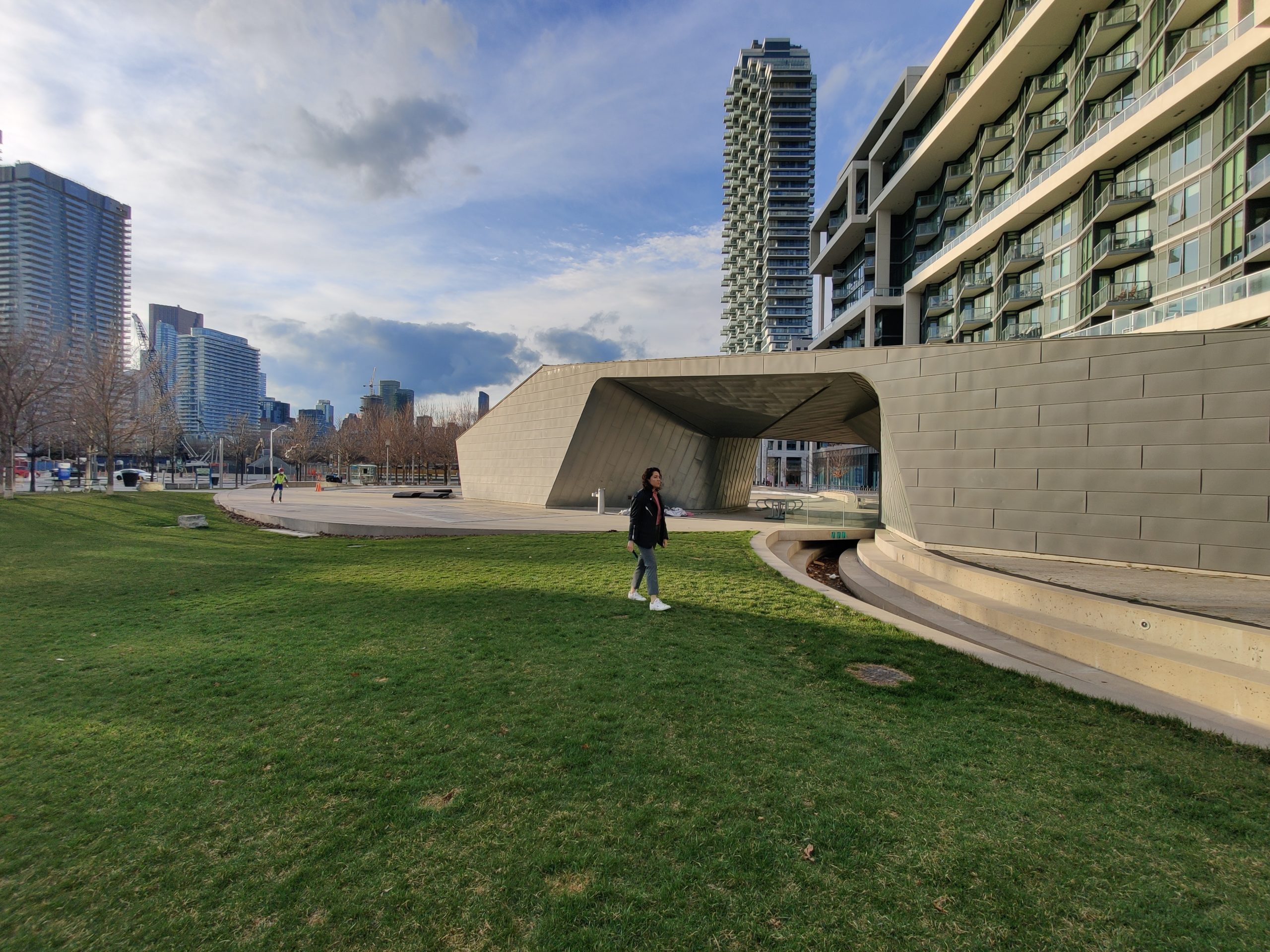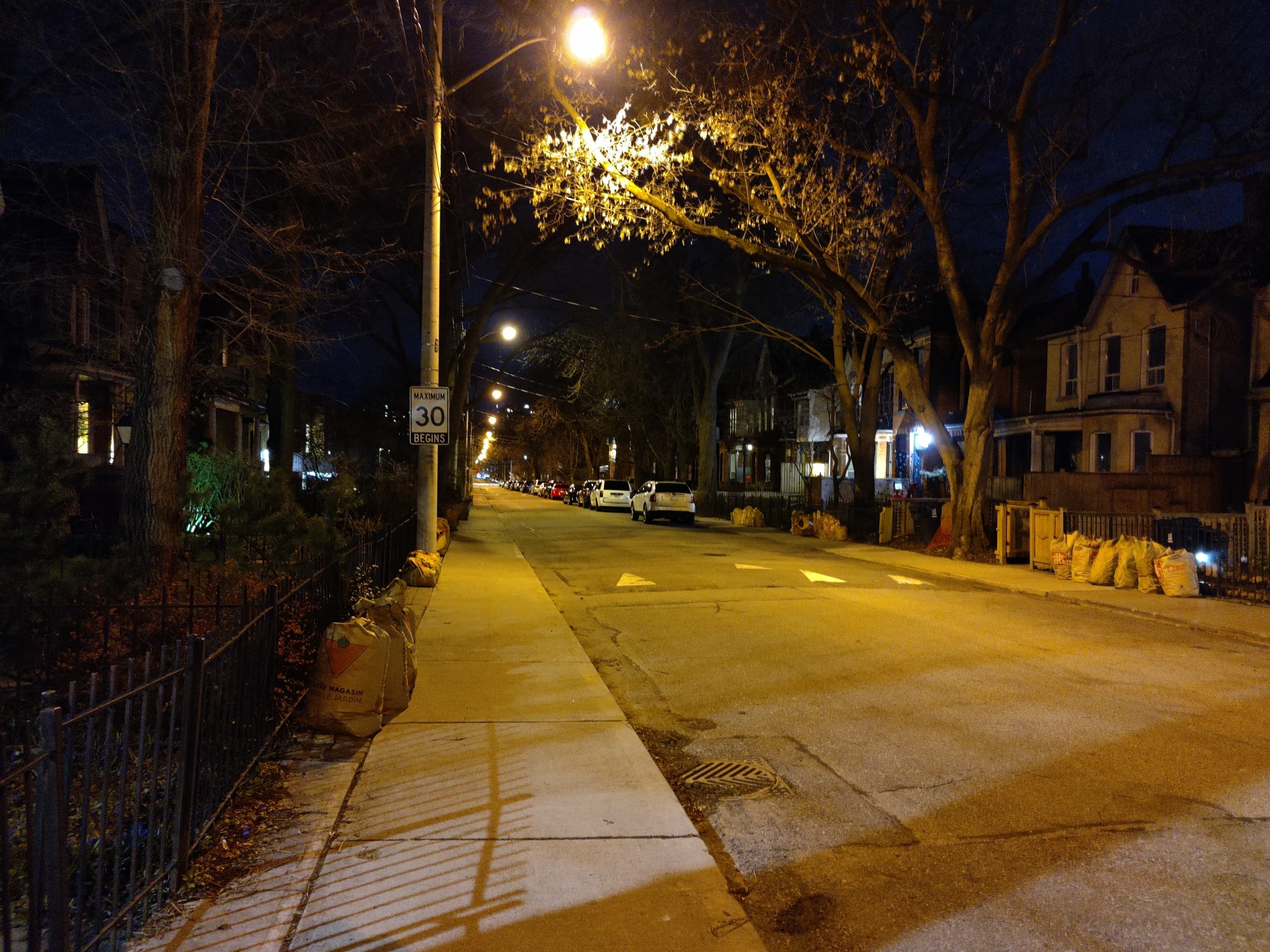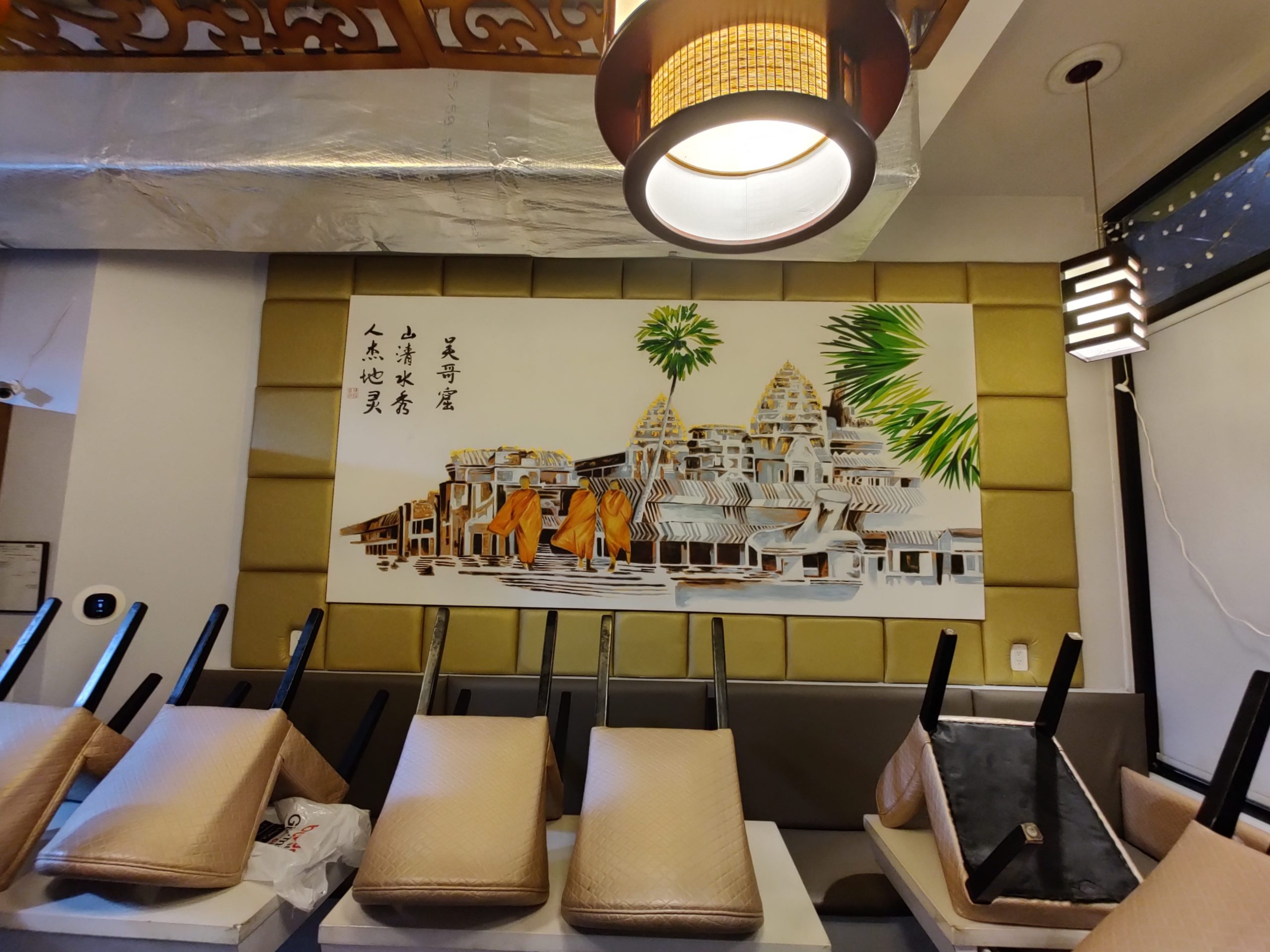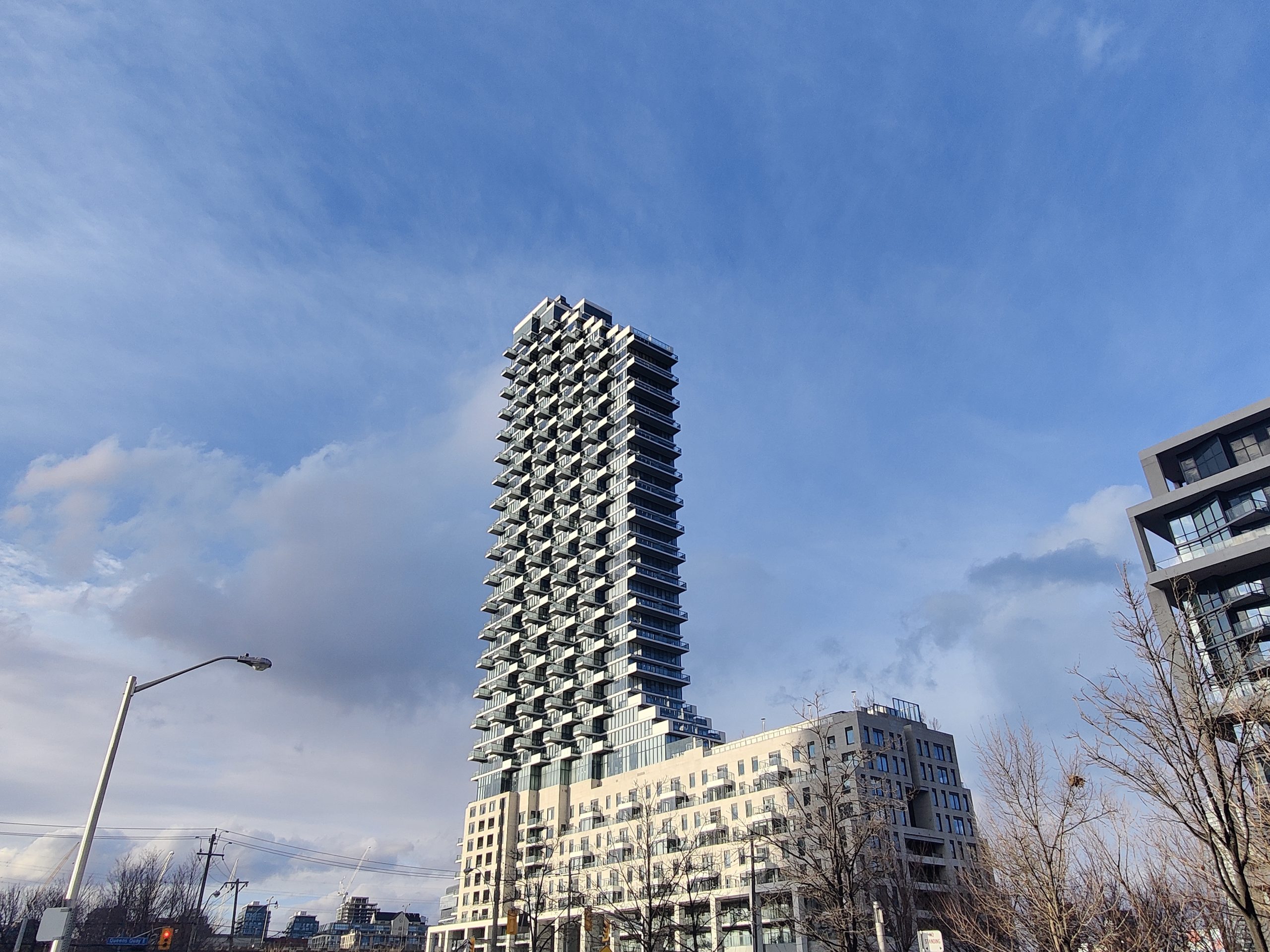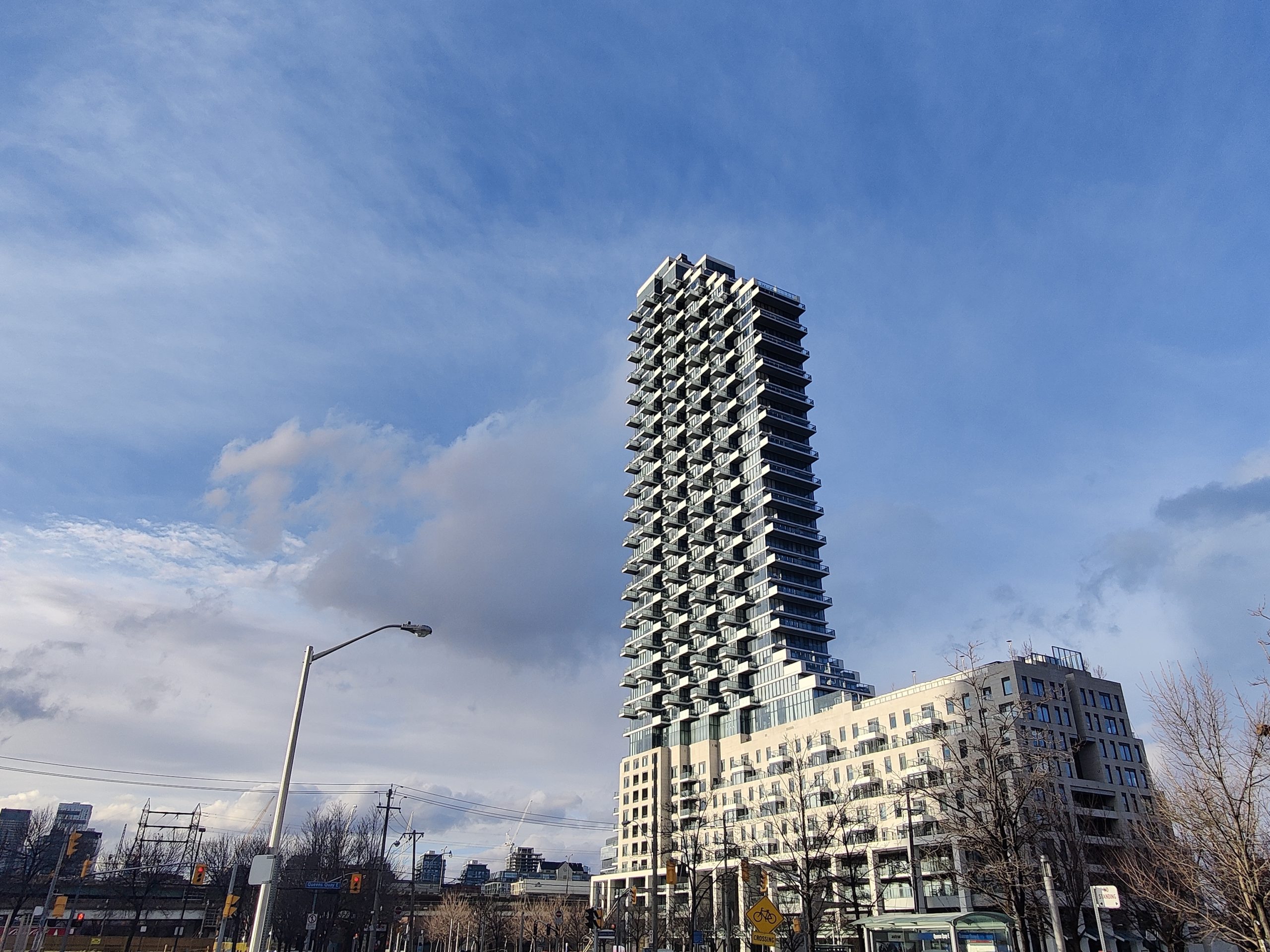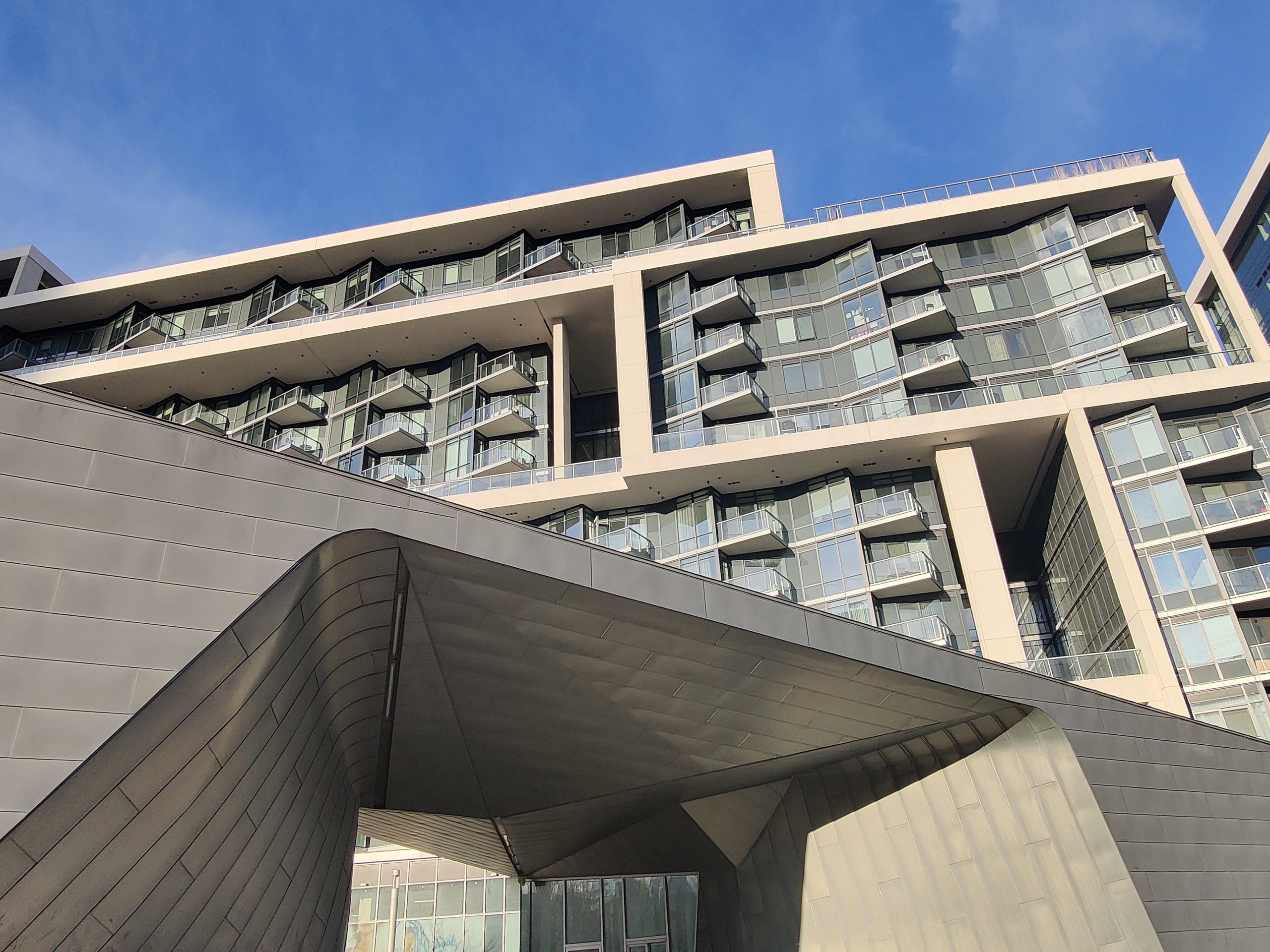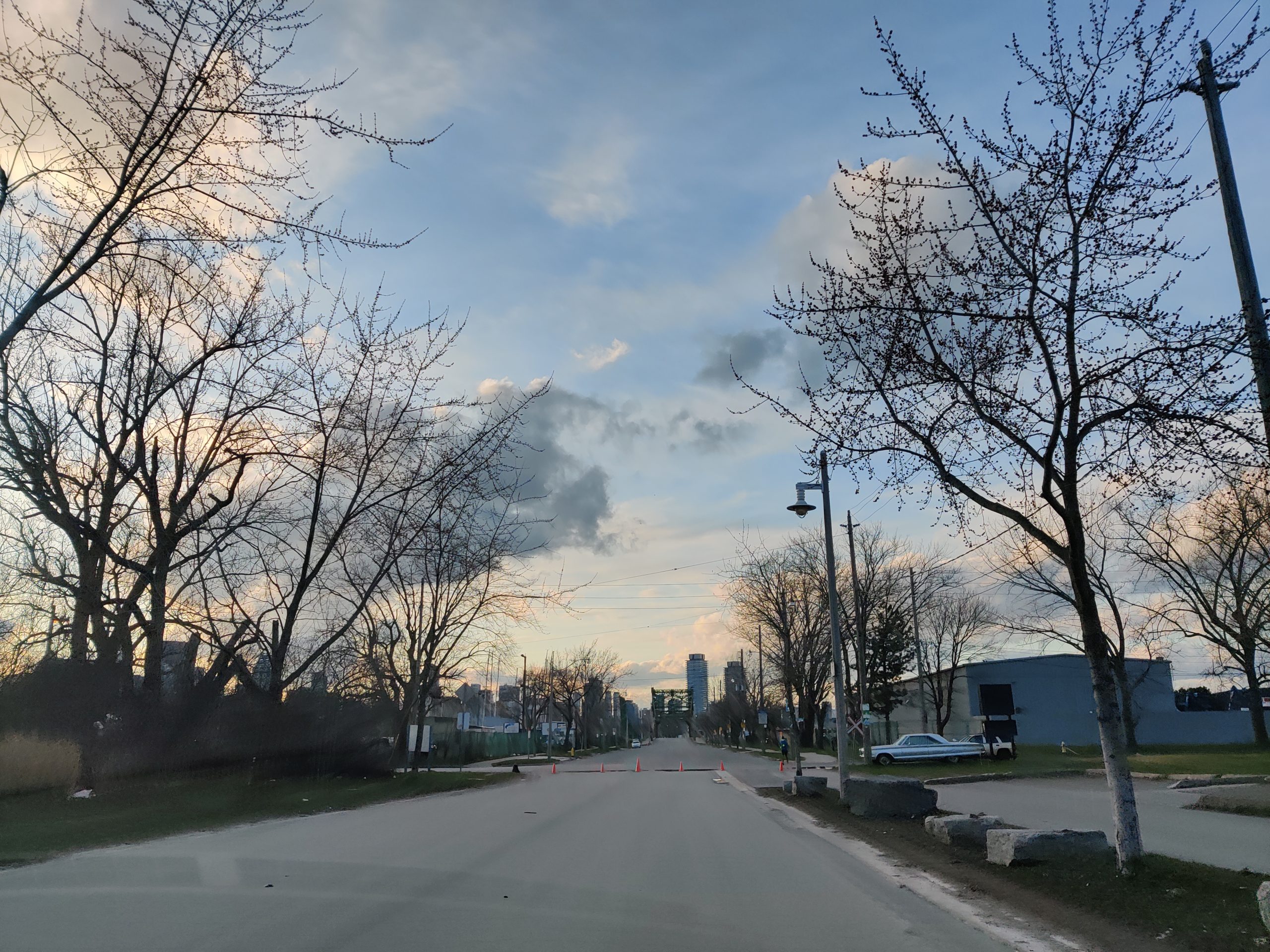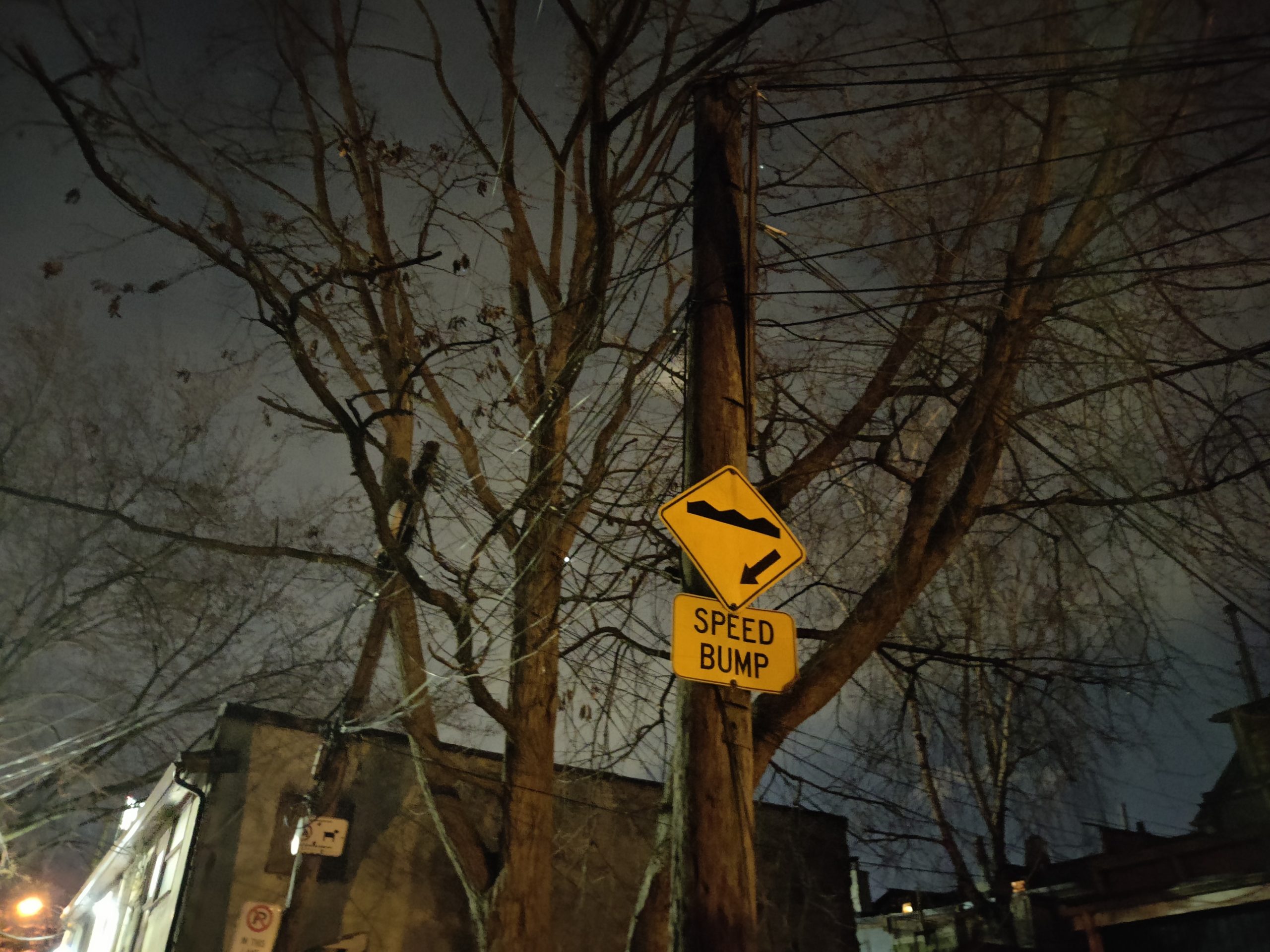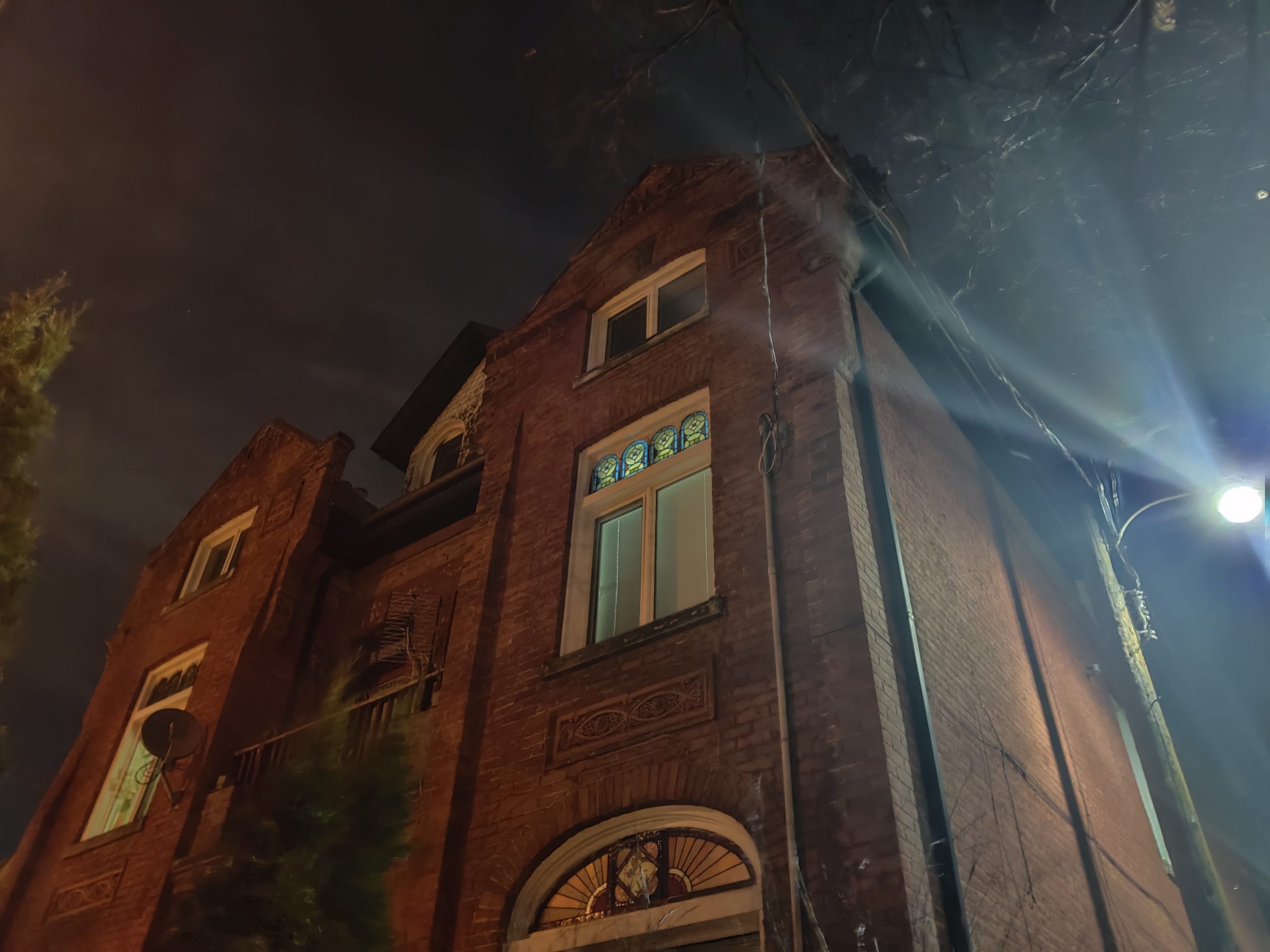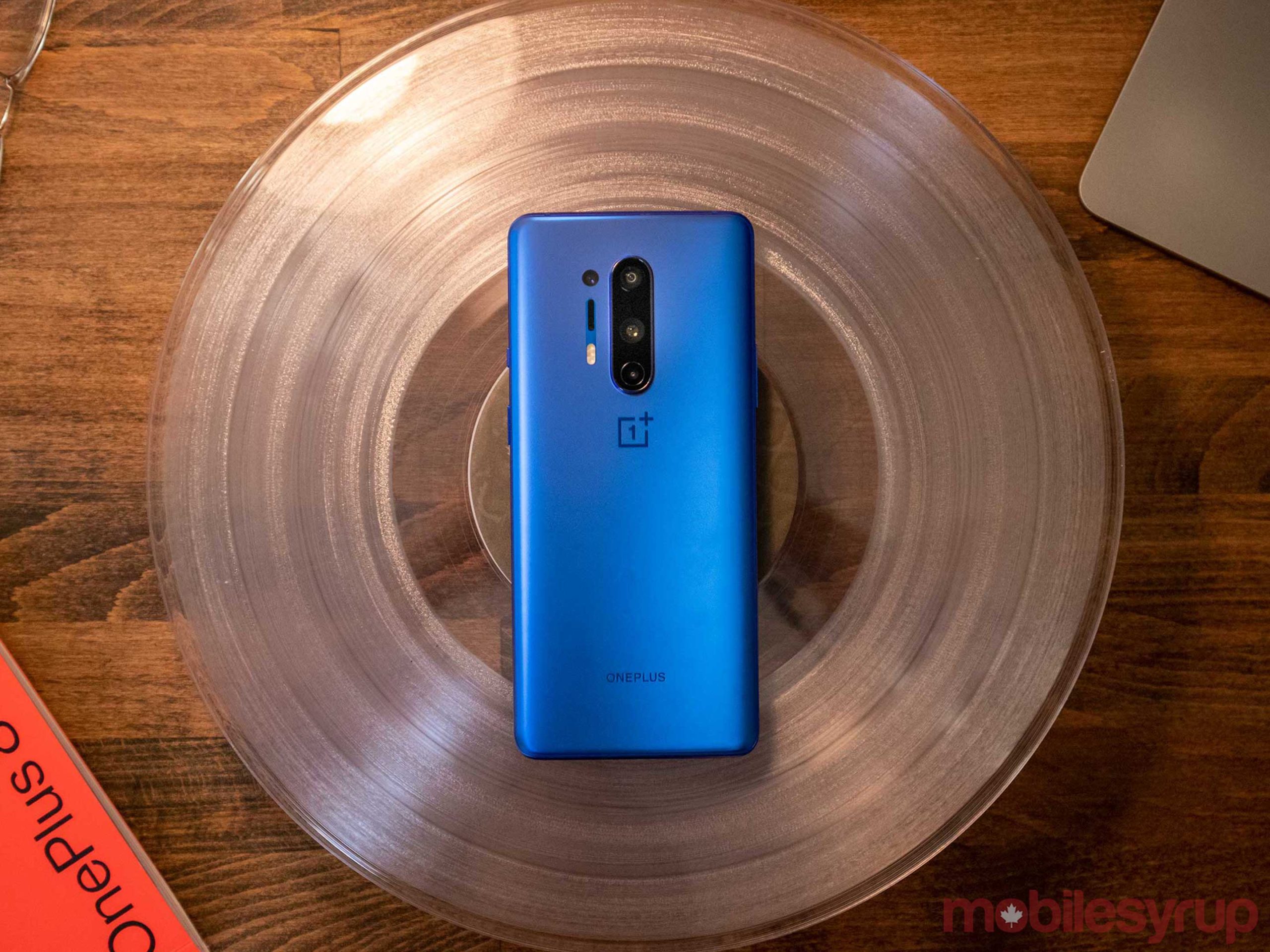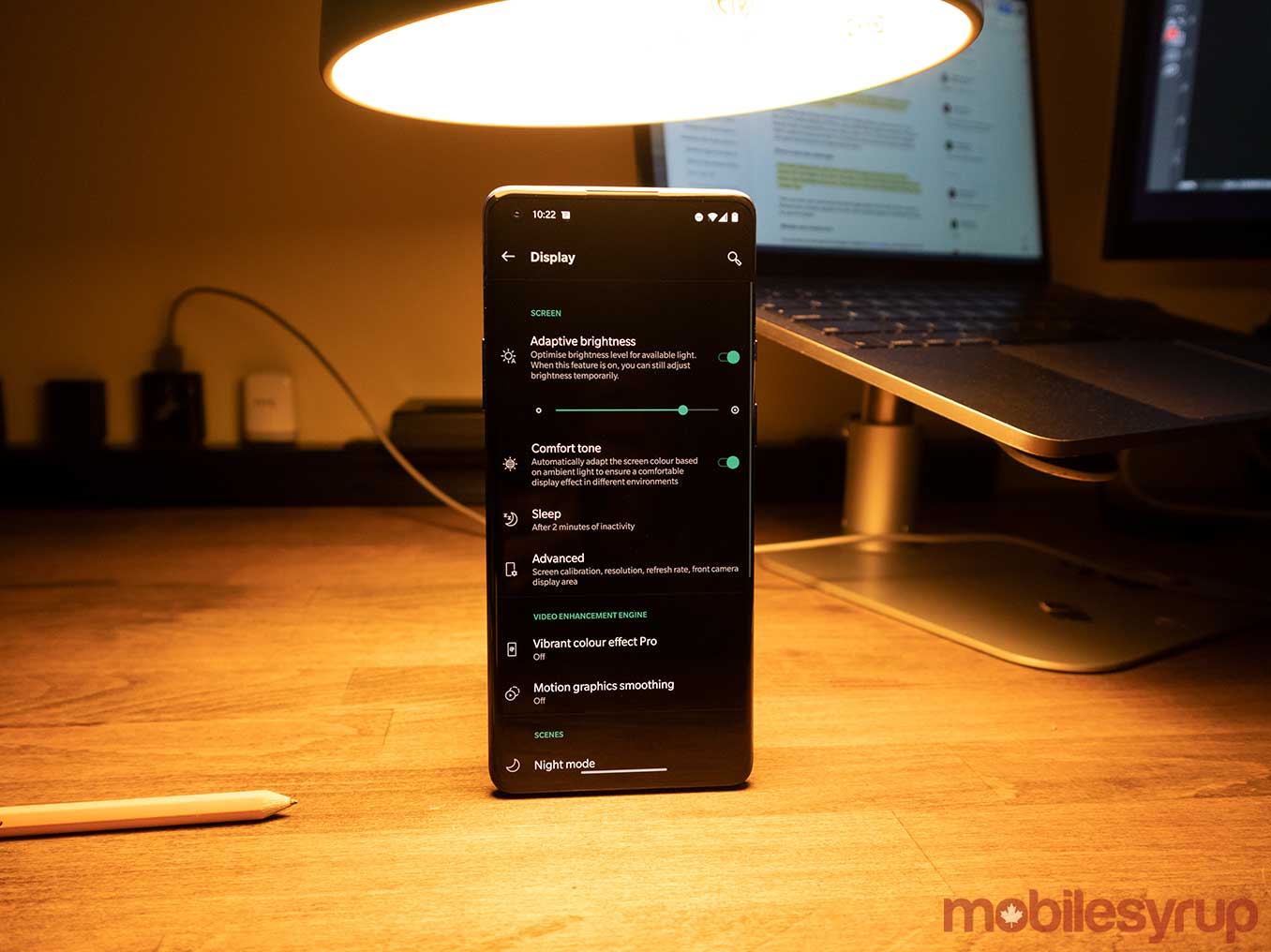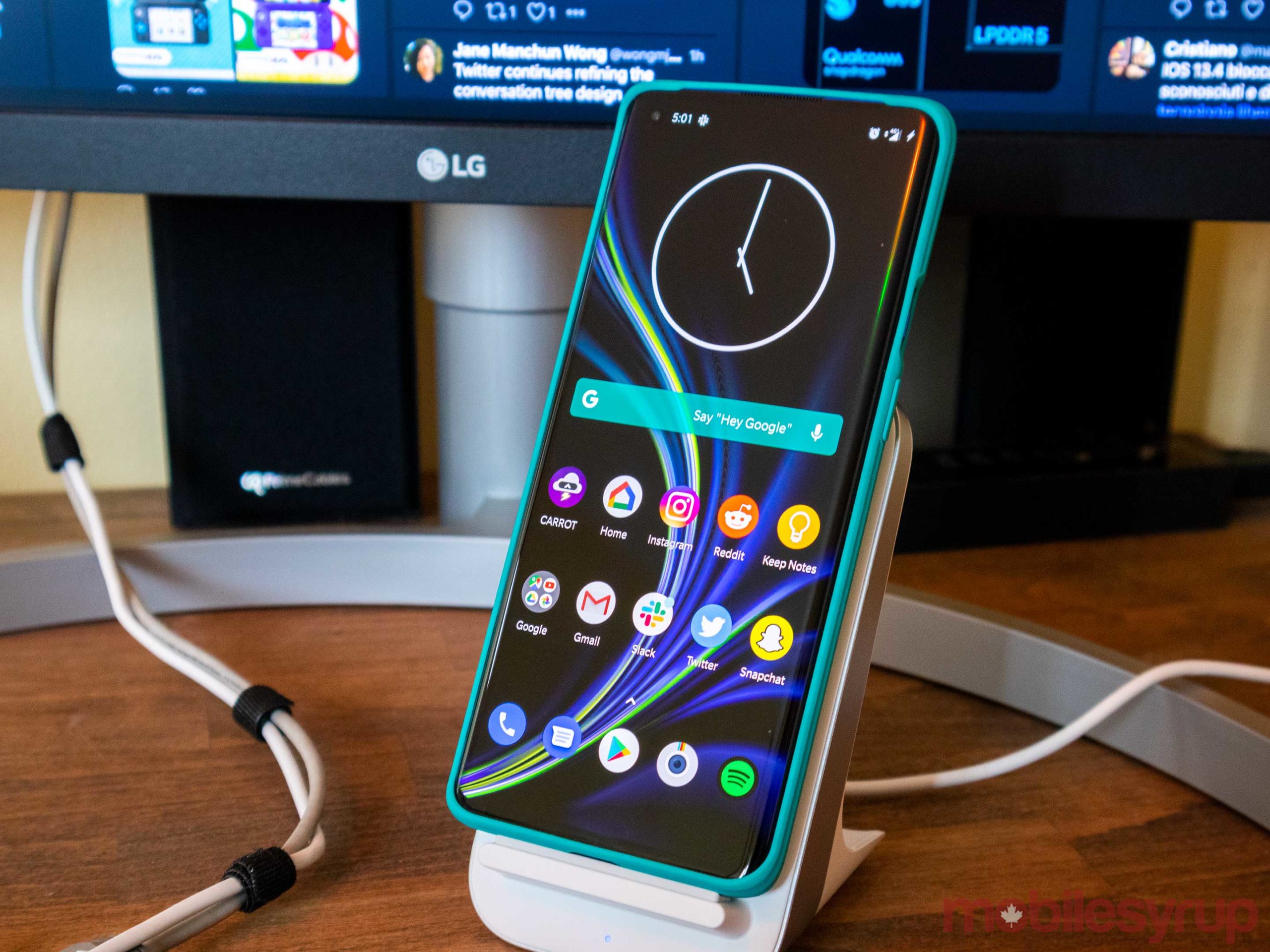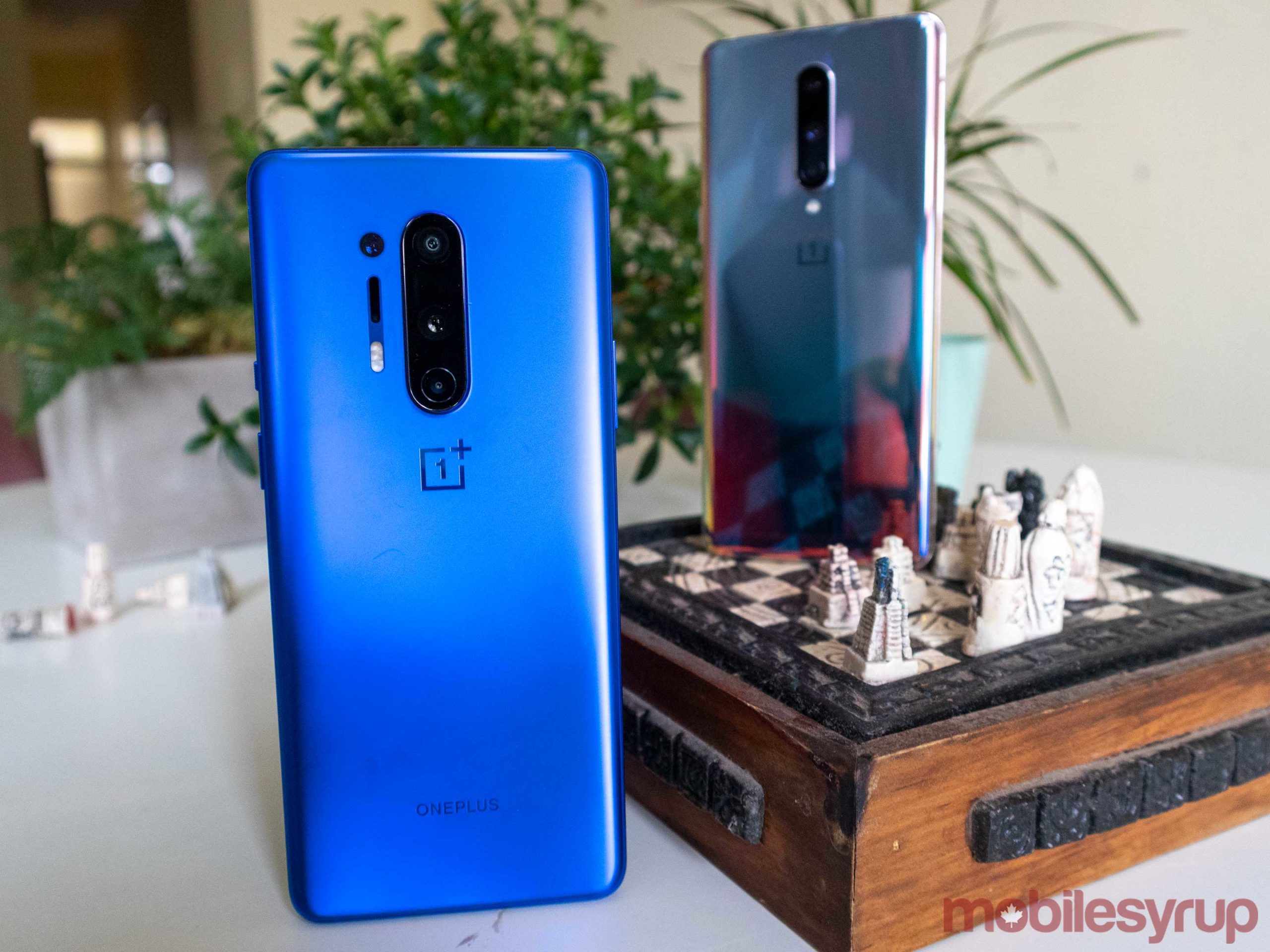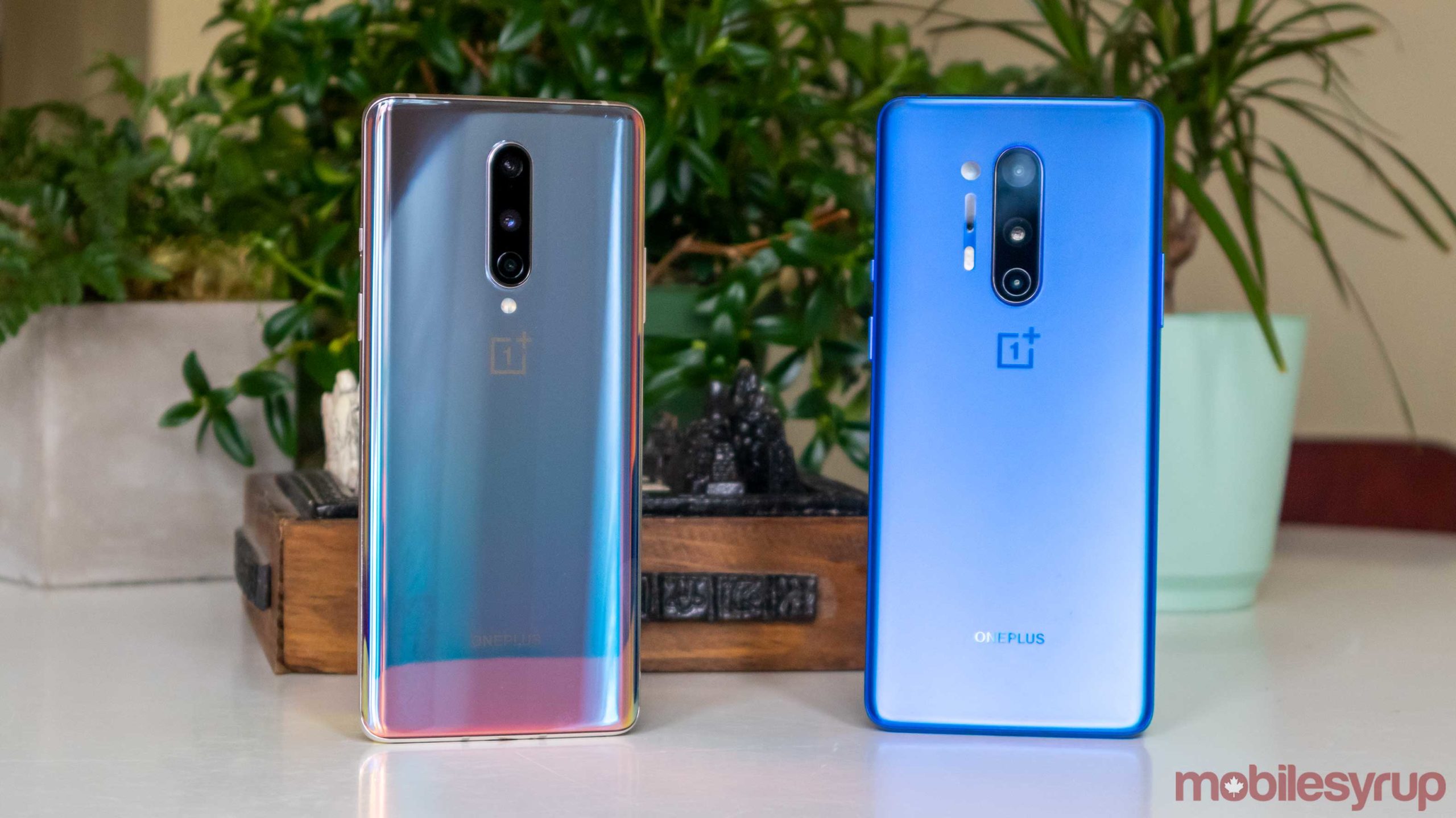
The Pros
- Killer display
- Exemplary build quality
- Fun cameras
- fast charging
- 5G and Wi-Fi 6
The Cons
- Software bugs
- Sometimes software doesn’t make a lot of sense
- No zoom lens on OnePlus 8
- high price tag in Canada
OnePlus has always held a special place in my heart. I watched the company announce its first phone in virtual reality, and the OnePlus 7T was the first high-end handset I ever reviewed.
It’s safe to say that I like this company and I want the best for it. With that being said, OnePlus still hasn’t made a perfect phone for people who aren’t tech enthusiasts.
While I praised last year’s OnePlus 7T for being a return to the company’s lower-cost roots, it’s clear that with the 8 and 8 Pro the Chinese manufacturer isn’t satisfied being a lower-cost alternative with high-end features.
This time around OnePlus isn’t just punching above its weight class; it’s featured in the title fight.
Because of OnePlus’ underdog history, tech reviewers often praise its phones because they offer beefy high-end specs for a lower price than other flagships. This made the company’s flaws easier to forgive because consumers were getting a bargain.
Sadly, that’s not the case anymore with this year’s very bold OnePlus 8 and 8 Pro. Both are packed with premium parts and top of the line price tags to go along with this refresh.
This means OnePlus has to step up since it can’t rely on a low price to soften the blow of minor issues.
Both phones are first-rate, but I’m not sure if they have enough star power to go mainstream with the likes of Samsung, Apple and Google.
Two hearts that beat as one
When comparing hardware, both smartphones share a lot of the same internals. The main differences stem in the camera setups, then trickle down to a few less noticeable hardware specs. In day-to-day use, you don’t notice a huge imbalance between the two.
For example, while both phones feature high-end screens, they’re not exactly identical. The OnePlus 8’s 6.55-inch display only has a 90Hz refresh rate and a 1080 x 2400 pixel resolution. It also only gets to 1,100 nits of brightness.
The OnePlus 8 Pro, on the other hand, features a 120Hz refresh rate, 1,300 nits of brightness and a 3168 x 1440 panel packed into its 6.78-inch display.
Both smartphones feature a hole-punch display in the top left corner where a small 16-megapixel camera sensor sits. It’s also worth mentioning the hole-punch display sits right at the bottom of the OnePlus 8’s status bar, making it appear uncentered. If that type of thing irks you, steer clear of the lower-end model.
The 8 Pro has DDR5 RAM while the regular 8 utilizes LPDDR4X RAM. In practice, the Snapdragon 865 processor pushes content around extremely efficiently on both of these phones.
Both the OnePlus 8 and OnePlus 8 Pro also support 5G and Wi-Fi 6. While 5G support isn’t widely available in Canada and won’t be for some time, the OnePlus 8 series can only work on ‘Sub-6’ networks. This means you can take advantage of Rogers’ initial 5G in Canada, but you won’t notice much of a difference compared to LTE speeds. When the carriers begin rolling out 3.5GHz networks next year, the OnePlus 8-series’ 5G modem will come into its own.
OnePlus 8 Pro
OnePlus 8
OnePlus 7T
Display
6.78-inch Fluid AMOLED, 3168 x 1440 pixels, 19:8:9 aspect ratio, 120Hz refresh rate
6.55-inch Fluid AMOLED, 1080 x 2400 pixels, 20:9 aspect ratio, 90Hz refresh rate
6.55-inch Fluid AMOLED, 2400 x 1080 pixels, 19.5:9 aspect ratio, 90Hz refresh rate
Processor
Snapdragon 865
Snapdragon 865
Snapdragon 855+
RAM
8GB/12GB of RAM
8GB/12GB of RAM
8GB of RAM
Storage
128GB, 256GB
128GB, 256GB
128GB, 256GB
Dimensions (in.)
165.3 x 74.35 x 8.5mm
160.2 x 72.9 x 8mm
160.94 x 74.44 x 8.13mm
Weight
199g
180g
190g
Rear Facing Camera
48-megapixel (f/1.78, OIS,EIS) + 8-megapixel (f/2.44, telephoto, OIS) + 48-megapixel (f/2.2, 119.7-degree ultra-wide angle) + 5-megapixel (f/2.4, colour filter)
48-megapixel (f/1.75, OIS,EIS) + 2-megapixel (f/2.4) + 16-megapixel (f/2.2, 116-degree ultra-wide angle)
48-megapixel (f/1.6, OIS) + 12-megapixel (f/2.2, telephoto) + 16-megapixel (f/2.2, ultra-wide angle)
Front Facing Camera
16-megapixel (f/2.45)
16-megapixel (f/2.0)
16-megapixel (f/2.0)
OS
Android 10 (OxygenOS 10.5)
Android 10 (OxygenOS 10.5)
Android 10
Battery
4510mAh
4300mAh
3800mAh
Network Connectivity
GSM/HSPA/LTE/SUB-6 5G/Wi-Fi 6
GSM/HSPA/LTE/SUB-6 5G/Wi-Fi 6
GSM/HSPA/LTE
Sensors
Fingerprint (in-display), accelerometre, gyro, electronic compass, ambient light sensor, proximity sensor
Fingerprint (in-display), accelerometre, gyro, electronic compass, ambient light sensor, proximity sensor
Fingerprint (in-display), accelerometre, gyro, proximity, compass
SIM Type
Dual nano-SIM
Dual nano-SIM
Nano SIM
Launch Date
April 14, 2020
April 14, 2020
September 26, 2019
Misc
Colours: Onyx Black, Glacial Green, Ultramarine Blue, Dolby Atmos stereo speakers, improved haptic vibration engine, alert slider
Colours: Onyx Black, Glacial Green, Interstellar Glow, Dolby Atmos stereo speakers, improved haptic vibration engine, alert slider
Colours:Frosted Silver, Glacier Blue | Face Unlock, stereo speakers, enhanced haptic engine, Dolby Atmos
Display
OnePlus 8 Pro
6.78-inch Fluid AMOLED, 3168 x 1440 pixels, 19:8:9 aspect ratio, 120Hz refresh rate
OnePlus 8
6.55-inch Fluid AMOLED, 1080 x 2400 pixels, 20:9 aspect ratio, 90Hz refresh rate
OnePlus 7T
6.55-inch Fluid AMOLED, 2400 x 1080 pixels, 19.5:9 aspect ratio, 90Hz refresh rate
Processor
OnePlus 8 Pro
Snapdragon 865
OnePlus 8
Snapdragon 865
OnePlus 7T
Snapdragon 855+
RAM
OnePlus 8 Pro
8GB/12GB of RAM
OnePlus 8
8GB/12GB of RAM
OnePlus 7T
8GB of RAM
Storage
OnePlus 8 Pro
128GB, 256GB
OnePlus 8
128GB, 256GB
OnePlus 7T
128GB, 256GB
Dimensions (in.)
OnePlus 8 Pro
165.3 x 74.35 x 8.5mm
OnePlus 8
160.2 x 72.9 x 8mm
OnePlus 7T
160.94 x 74.44 x 8.13mm
Weight
OnePlus 8 Pro
199g
OnePlus 8
180g
OnePlus 7T
190g
Rear Facing Camera
OnePlus 8 Pro
48-megapixel (f/1.78, OIS,EIS) + 8-megapixel (f/2.44, telephoto, OIS) + 48-megapixel (f/2.2, 119.7-degree ultra-wide angle) + 5-megapixel (f/2.4, colour filter)
OnePlus 8
48-megapixel (f/1.75, OIS,EIS) + 2-megapixel (f/2.4) + 16-megapixel (f/2.2, 116-degree ultra-wide angle)
OnePlus 7T
48-megapixel (f/1.6, OIS) + 12-megapixel (f/2.2, telephoto) + 16-megapixel (f/2.2, ultra-wide angle)
Front Facing Camera
OnePlus 8 Pro
16-megapixel (f/2.45)
OnePlus 8
16-megapixel (f/2.0)
OnePlus 7T
16-megapixel (f/2.0)
OS
OnePlus 8 Pro
Android 10 (OxygenOS 10.5)
OnePlus 8
Android 10 (OxygenOS 10.5)
OnePlus 7T
Android 10
Battery
OnePlus 8 Pro
4510mAh
OnePlus 8
4300mAh
OnePlus 7T
3800mAh
Network Connectivity
OnePlus 8 Pro
GSM/HSPA/LTE/SUB-6 5G/Wi-Fi 6
OnePlus 8
GSM/HSPA/LTE/SUB-6 5G/Wi-Fi 6
OnePlus 7T
GSM/HSPA/LTE
Sensors
OnePlus 8 Pro
Fingerprint (in-display), accelerometre, gyro, electronic compass, ambient light sensor, proximity sensor
OnePlus 8
Fingerprint (in-display), accelerometre, gyro, electronic compass, ambient light sensor, proximity sensor
OnePlus 7T
Fingerprint (in-display), accelerometre, gyro, proximity, compass
SIM Type
OnePlus 8 Pro
Dual nano-SIM
OnePlus 8
Dual nano-SIM
OnePlus 7T
Nano SIM
Launch Date
OnePlus 8 Pro
April 14, 2020
OnePlus 8
April 14, 2020
OnePlus 7T
September 26, 2019
Misc
OnePlus 8 Pro
Colours: Onyx Black, Glacial Green, Ultramarine Blue, Dolby Atmos stereo speakers, improved haptic vibration engine, alert slider
OnePlus 8
Colours: Onyx Black, Glacial Green, Interstellar Glow, Dolby Atmos stereo speakers, improved haptic vibration engine, alert slider
OnePlus 7T
Colours:Frosted Silver, Glacier Blue | Face Unlock, stereo speakers, enhanced haptic engine, Dolby Atmos
The pair feature wired OnePlus 30T Warp erging that can charge both phones up to 50 percent in around 25 minutes. The Pro has the larger battery clocking in at 4,510mAh, while the OnePlus 8 features a 4,300mAh power cell. The Pro also features wireless charging, which I’ll get more into later.
Zooming in on perfection
Coming into the OnePlus 8 Pro and 8, I had high hopes riding off of my love for the OnePlus 7T’s camera. After a few days of testing, the phones left me with a positive impression, but there are still some flaws in the images.
I’m a big fan of the cooler wash I get from OnePlus photos. Each phone shares a similar 48-megapixel main camera with f/1.7 aperture and they can produce stunning pictures.
Bearing that in mind, not every shot is as consistent and in my experience, you can get more duds than not if you aren’t careful.
Beyond its primary sensor, the OnePlus 8 Pro is also packing an 8-megapixel 3x zoom lens with an f/2.44 aperture, which I found worked well. You can digitally push it further, but it doesn’t look great.
The final OnePlus 8 Pro shooter is a 48-megapixel 119-degree ultra-wide-angle lens. Accompanying all three of these is a five-megapixel colour filter camera that allows for some unique photo opportunities. Both of these are fun add-ons to the camera and not much more.
The OnePlus 8’s main camera, on the other hand, is flanked by a 16-megapixel 116-degree ultra-wide-angle lens and a two-megapixel macro camera. Both of these are a ton of fun to use and can produce some pretty killer looking shots. However, I’d trade either one for the 3x telephoto on the 8 Pro.
For those wondering, OnePlus’ ‘Nightscape‘ mode has returned again and works better than ever to brighten low-light scenes.
All things considered, both of these phones are capable of producing amazing pictures, but as I said with the OnePlus 7T, you need to take a few seconds composing your shot to really get the most out of the OnePlus 8 series cameras.
OnePlus 8 Pro
OnePlus 8
The showstopper
The real star of the show is the OnePlus 8 Pro. It’s easily the best phone OnePlus has ever made, even if it doesn’t feature a pop-up camera.
It’s wicked fast, feels extremely premium, works impressively well and packs all of this into an appealing form factor. The handset is 8.5mm thin and weighs 199g, so it feels very sturdy to hold. The soft-touch finish applied to the back of the phone further demonstrates OnePlus’ dedication to craftsmanship.
OnePlus fans will be happy to hear this time around the company has certified the 8 Pro with an IP68 water and dustproof rating, so it should be able to handle a bit of water if you happen to drop it in a puddle or the sink.
On the software side of things, the phone’s 120Hz display allows for some cool tricks. If you dive into the ‘Display Settings’ you’ll find an option called ‘Motion graphics smoothing.’ This is the dreaded motion smoothing you hear about so often on TVs. I only ever had one instance where it added the soap opera effect to a YouTube clip. Other than that, it worked fine and sports fans and gamers will appreciate the feature.
Motion smoothing hasn’t been picking up much adoption on smartphones, but 120Hz displays have. All of Samsung’s S20 phones, among other options like the Asus ROG Phone 2, are slowly making high refresh rates an industry standard. And it’s hard to go back to a phone with a 60Hz display after using something with 120Hz.
Also in the Settings menu, you’ll see a comfort tone toggle that works like the Pixel 4’s ‘Ambient EQ’ and Apple’s ‘True Tone.’ Its function is to match the display’s white balance to the ambient light temperature in the room. Therefore in rooms with orange light, the screen has an orangish tinge.
There have also been some heavy-duty technologies added to the OnePlus 8 Pro to allow for wireless 30-watt Warp Charging, arguably one of the most requested features by OnePlus fans during the past few releases.
The gist of it is that the device can charge very quickly on the company’s proprietary charging stand. But it can only charge at regular speed on other Qi charging surfaces. Wireless Warp Charge is impressive, but I would have been just as happy with standard Qi charging.
In the end, there’s a lot to like about the OnePlus 8 Pro. It’s a premium handset through and through. Unfortunately for consumers, it also comes with a very premium price tag of $1,400 CAD. This puts the phone squarely in line with the iPhone 11 Pro and the Galaxy S20+.
I’m hard-pressed to say the 8 Pro is better than those two phones, but it comes down to subjective aspects. On a spec by spec breakdown, OnePlus matches these competitors at almost every turn this time around. So for most people, I don’t think the 8 Pro is a must-buy, but it’s definitely worth comparing to Samsung, Apple and Google’s top-of-the-line offerings the next time you want a new phone.
The heavy lifter
After seeing how much the 8 Pro costs and what it offers, you can look at the OnePlus 8 in two ways. It’s either a reasonably priced phone that’s not weighed down by flashy features, or it’s a lacklustre offering beside its higher-end sibling.
To me, it’s more of the former. I think the phone is fantastic and while it does have some drawbacks, its more user-centric focus likely makes it a better buy for the average person.
For instance, the phone still has great haptic feedback, an accurate and sharp display, fast speeds, long-lasting battery life and a decent camera. These are all things regular people want in a phone.
My first reaction to the phone was how gorgeous the ‘Interstellar Glow’ colour looks, but afterwards, it was how comfortable the device felt to hold. Its smaller frame means it’s roughly as big as last year’s 7T, although this time the curved display and glossy back make it feel much nicer in your hand.
Despite this phone not being the company’s flagship device, it still carries enough of the “flagship killer” mindset to give handsets that cost hundreds of dollars more a run for their money. If I was looking for a new smartphone myself, I would heavily consider the OnePlus 8.
However, we sadly live in a time where flagships can cost nearly $2,000 so the OnePlus 8 comes in at a pricy $1,099 CAD. This, unfortunately, makes the phone more expensive than the iPhone 11, but less than the Samsung Galaxy S20. In this case, the iPhone is the better value, but the specs and features included in the OnePlus 8 are more impressive.
While I have no major qualms with the phone specifically, I wish OnePlus would have priced it a lot closer to last year’s $800 OnePlus 7T.
A look to the future
Some people might find this section a little subjective, but I think there are a few things OnePlus can do to smooth out its software. It even seems like the company is already on the way to solving some of these problems. Its next Open Ears Forum is focused on OxygenOS and the company just launched a new IDEAS program to source more requested features.
I understand OnePlus’ inherent software concept is to be as minimal as possible, but I think at this point it has implemented enough of its own features and co-opted enough of Google’s functionality, that it’s now a weird mix of OnePlus and Google.
For instance, OnePlus’ ambient display appears when you tap on the phone’s screen when it’s off. Google also has an ambient display that shows up when the phone is plugged in.
This weird mishmash of features from two manufacturers is a bit odd, and from a design standpoint, I don’t like it.
OnePlus has a killer design that’s evident in its marketing material and press guides, but it fails to push it appealingly in OxygenOS.
I was hoping issues like this were going to be fixed when the company announced a new rebranding a few weeks ago, but it seems like those design ideals haven’t made their way into the company’s software.
Other issues are just bugs, like how both the ‘Privacy’ and the ‘Location’ section in the Setting app don’t have coloured icons while every other heading does.
The phone’s ‘Horizon light’ feature (which lights up the curved edges of the displays when you get a notification) doesn’t work when the phone is face down on a table, arguably where it would be the most useful.
I’ve also experienced some annoying software issues that detract from the overall experience, but they seem to be very hit and miss. The OnePlus 8 has been incredibly consistent since I set it up, while the OnePlus 8 Pro has needed to be factory reset once.
In the end, if you need dependable software experiences Google and Apple provide more cohesive options. Hopefully, one day OnePlus can iron out these kinks and implement a cohesive yet minimal theme on top of Android, but for now, it’s still working things out.
OnePlus says that a few of my main bugs will be fixed with an April 15th software patch.
In the blink of an eye
The OnePlus One came out six years ago and in that time the company has grown considerably into not just an upstart “Flagship killer,” but a fully-fledged brand with a defined fanbase and ideals.
The OnePlus 8 series is still catering to those fans and are easily the best phones the company has ever produced, but I bet my bottom dollar that the OnePlus 9 is going to be one of the best phones out period when it hits the market.
It took Google six years to make the Pixel 2 from when it started working on its Nexus project. I think that’s when Google started honing its mobile design chops to create a cohesive software and hardware experience.
If OnePlus’ history is any indication, it’s building towards the same moment with its smartphones and OxygenOS, and I’m excited about it.
Great phones, but they're hard to get your hands on
In terms of the phones, I think most OnePlus fans and even average consumers who are looking for a cool Android device, will be very happy to take the OnePlus 8 for a spin. Its high-end specs, build-quality and forward-looking features should be more than enough to keep most people happy for a few years.
The higher-end OnePlus 8 Pro is another story. It's a device I wouldn't pitch to regular people like my mom or non-techie friends because the small improvements it has over the OnePlus 8 aren't worth the extra cost. That said, if you're looking for the premier OnePlus-dream, it doesn't get much closer than the OnePlus 8 Pro.
The only warning I'll give these people is that you need to be prepared to live with a few bugs if you take OnePlus into your lives. A quick restart usually fixes things, but issues like I listed above can still cause trouble.
For Canadians specifically, these phones will be a tough sell because no carriers offer them. Getting a $1,400 iPhone on a contract from a carrier drops the phone's upfront cost considerably. There's no way not to pay full price for a OnePlus phone in Canada, so as fantastic and future proof as these phones are they'll be hard to get in front of Canadian consumers.
For now, you can only buy the phones outright and unlocked from OnePlus.com. The OnePlus 8 Pro starts at $1,400 in Canada and the OnePlus 8 comes in at $1,100.
"There's no way not to pay full price for a OnePlus phone in Canada, so as fantastic and future proof as these phones are they'll be hard to get in front of Canadian consumers"
MobileSyrup may earn a commission from purchases made via our links, which helps fund the journalism we provide free on our website. These links do not influence our editorial content. Support us here.



